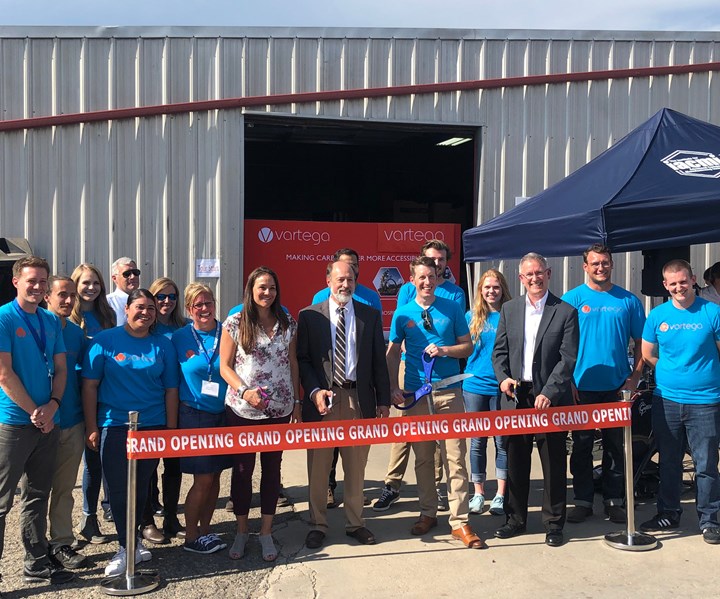Carbon fiber recycler Vartega expands capacity
Colorado-based Vartega cuts the ribbon to officially open its new 10,000-square-foot manufacturing space for the recycling of uncured carbon fiber prepregs.

Vartega employees stand by during the ribbon-cutting of the company’s new 10,000-square-foot facility in Golden, Colo., U.S. Holding scissors are Katie Woslager, advanced industries senior manager at the Colorado Office of Economic Development and International Trade; Ed Pilpel, Vartega board member and technical advisor to PolyOne; Andrew Maxey, CEO and founder of Vartega; and John Hopkins, CEO of IACMI. Photo | CW
Vartega (Golden, Colo., U.S.) on July 23 cut the ribbon to officially open its new 10,000-square-foot manufacturing facility designed to allow the company to take the next steps in its efforts to expand its carbon fiber recycling operations and products.
Andrew Maxey, CEO and founder of Vartega, thanked the Vartega team, which now numbers about 15 people, for their help in maturing the company and its solvolysis-based recycling technology. Maxey also pointed to the State of Colorado, the Colorado Cleantech Industries Assn., Colorado State University, the University of Colorado, the Colorado School of Mines and the Institute for Advanced Composites Manufacturing Innovation (IACMI; Knoxville, Tenn., U.S.) as particularly critical to the company’s growth. “I am so very grateful for the ecosystem that holds us up,” he said. “Our successes — and our future successes — are represented in this ribbon-cutting.”
Maxey noted that he launched Vartega in his garage five years ago when carbon fiber recycling was in its infancy. He reflected on the fact that although carbon fiber recycling technology itself is quite evolved, the markets that might consume recycled carbon fiber are just now starting to take shape — a combination that has created some market headwinds for the global carbon fiber recycling industry. Still, said Maxey, there are applications on the horizon that seem to be excellent targets for recycled carbon fiber, including autonomous vehicles, sporting goods and additive manufacturing. “We are closing the gap in the materials supply chain,” he said.
John Hopkins, CEO of IACMI, was on hand for the ribbon-cutting and noted Maxey’s significant involvement in and support of IACMI. Vartega, he said, has taken full advantage of the partnerships and cooperation that IACMI fosters to help mature the composites industry. “I appreciate what Andrew has done personally to help grow this industry,” he said.
From the new facility, Vartega will initially process 168 metric tons of 65% FVF carbon fiber prepreg annually, producing 109 metric tons of carbon fiber and 59 metric tons of epoxy resin. Most of that carbon fiber will be compounded off-site with a thermoplastic resin for injection molding operations. Vartega also has a twin-screw extruder on-site to do some of its own compounding.
By the end of 2020, Maxey said, Vartega plans to install its first Hardware as a Service (HaaS) product at IACMI’s SURF manufacturing demonstration facility in Corktown, Detroit, Mich., U.S. HaaS is a modular, scalable, 100-metric-tons/year carbon fiber recycling system designed for installation at a composites fabrication facility. The customer — fabricator — will be able to use HaaS for on-site processing of uncured prepreg scrap to recycle carbon fiber and resin. The materials that result can be either integrated back into the customer’s manufacturing operations or sold onto the open market. Customers who install HaaS will pay a subscription fee for the equipment, software and associated technology.
The ribbon-cutting coincided with IACMI’s summer membership meeting in Denver, Colo., and was attended by about 200 people. The ribbon was cut by Maxey; Hopkins; Ed Pilpel, Vartega board member and technical advisor to PolyOne (Avon Lake, Ohio, U.S.); and Katie Woslager, advanced industries senior manager at the Colorado Office of Economic Development and International Trade.
Related Content
The potential for thermoplastic composite nacelles
Collins Aerospace draws on global team, decades of experience to demonstrate large, curved AFP and welded structures for the next generation of aircraft.
Read MoreManufacturing the MFFD thermoplastic composite fuselage
Demonstrator’s upper, lower shells and assembly prove materials and new processes for lighter, cheaper and more sustainable high-rate future aircraft.
Read MoreThe lessons behind OceanGate
Carbon fiber composites faced much criticism in the wake of the OceanGate submersible accident. CW’s publisher Jeff Sloan explains that it’s not that simple.
Read MoreInfinite Composites: Type V tanks for space, hydrogen, automotive and more
After a decade of proving its linerless, weight-saving composite tanks with NASA and more than 30 aerospace companies, this CryoSphere pioneer is scaling for growth in commercial space and sustainable transportation on Earth.
Read MoreRead Next
All-recycled, needle-punched nonwoven CFRP slashes carbon footprint of Formula 2 seat
Dallara and Tenowo collaborate to produce a race-ready Formula 2 seat using recycled carbon fiber, reducing CO2 emissions by 97.5% compared to virgin materials.
Read MoreVIDEO: High-volume processing for fiberglass components
Cannon Ergos, a company specializing in high-ton presses and equipment for composites fabrication and plastics processing, displayed automotive and industrial components at CAMX 2024.
Read More“Structured air” TPS safeguards composite structures
Powered by an 85% air/15% pure polyimide aerogel, Blueshift’s novel material system protects structures during transient thermal events from -200°C to beyond 2400°C for rockets, battery boxes and more.
Read More


























